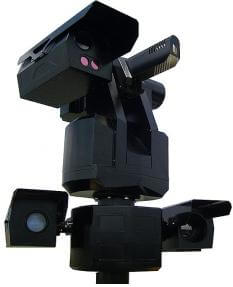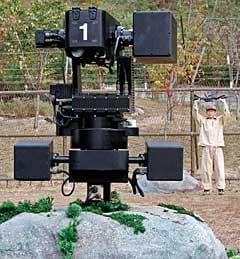Armed Robots Deployed By South Korea in Demilitarized Zone

Share
South Korea has announced that it is performing a trial run to determine if armed robots could be used to help patrol their demilitarized zone with North Korea. These autonomous turrets were developed in part by Samsung Techwin (their SGR-A1 model) and are capable of discerning humans from their surroundings at 500 meters. Each comes equipped with a machine gun as well as video and audio surveillance. South Korea has not revealed many of the specifics of the trial beyond that the robots were installed in June and would be tested through the end of the year. If successful, the project may be expanded to include more of the 250 km long Korean DMZ. This could lead to potentially one of the biggest adoptions of armed robots in the world.
Unfortunately, putting weapons on robots is nothing new. There are a variety of gun-toting mobile robots in development for the US Army, and armed automated turrets have been used defensively in Iraq's Green Zone for years now. The Korean demilitarized zone, however, represents hundreds of thousands of man-hours spent every year on surveillance, and is one of the major causes of South Korea's two-year mandatory army service for males. The incentive to automate monitoring of large sections of the DMZ must be enormous. According to Stars and Stripes, who spoke to key officials and Samsung Techwin, the robotic turrets cost about $200,000 each, which is more expensive than a soldier, but still might represent a good investment strictly in terms of labor costs.
While the exact capabilities of the turrets used in the trial have not been announced, they are thought to be close to or identical to the SGR-A1. That robot has been well demonstrated over the years. Below is an old video (from 2006) that shows most of what it can do:
Also, here's a narrative-like video that shows how the turret would work in "real life". It's pretty poorly made, but maybe you'll get a laugh out of it:
Be Part of the Future
Sign up to receive top stories about groundbreaking technologies and visionary thinkers from SingularityHub.


As you can see in the videos, the SGR is remotely monitored by human operators, but it does have autonomous functions that can be turned on. When tele-operated, the turrets can correspond with enemies in the field via speakers. When automated...they can hit what they're aiming for. Advanced computer vision software identifies human shapes using heat and motion detectors. The DMZ provides an ideal space for the turrets, as anyone moving on the active side is considered a hostile person and can be shot.
I'm always a little uneasy when I see the act of killing being automated. Granted, the South Korean officials are stressing that these turrets are simply being used in an observational capacity at the moment, but still. These robots are packing heat. If they're fully installed the length of the DMZ, then chances are they will eventually shoot someone. That's a scary concept, but one we may have to become used to in certain situations. Asymmetric warfare (which seems to be the only kind of war people fight these days) means that the more powerful side have to monitor and protect large spaces from a relatively few number of hostiles. Huge areas, low activity - these make a human bored and unlikely to do their job well over long periods of time, which means automated systems are the logical answer. We may see non-lethal varieties of these turrets surrounding military bases, airports, and other sensitive areas in the near future. That is supposing, of course, that they don't set off an international incident in Korea first.
[image credits: Samsung Techwin, Kim Dong-Joo AFP/Getty Images]
[video credit: Samsung Techwin]
[source: Stars and Stripes]
Related Articles

These Robots Are the Size of Single Cells and Cost Just a Penny Apiece

In Wild Experiment, Surgeon Uses Robot to Remove Blood Clot in Brain 4,000 Miles Away

A Squishy New Robotic ‘Eye’ Automatically Focuses Like Our Own
What we’re reading

